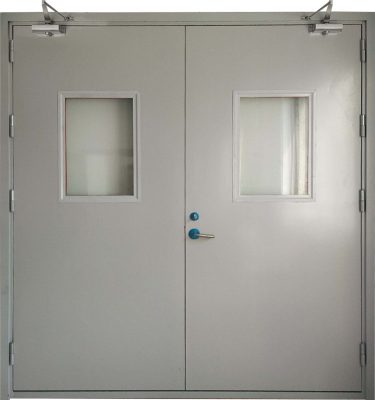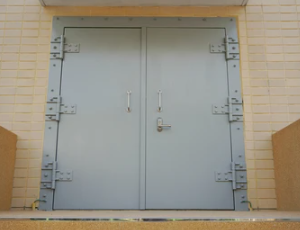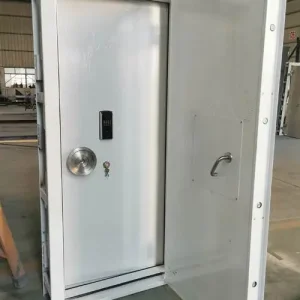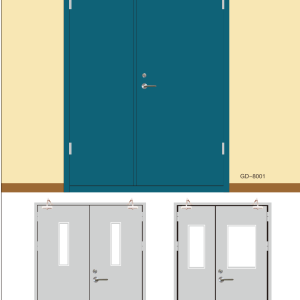Fire Door Installation Standards

I. Quality
Compliance: Fire doors must meet relevant national standards and regulations, possessing valid fire certificates and inspection reports.
Material Requirements: Fire doors should be constructed from approved materials, such as steel or wood, with fire resistance ratings that comply with design specifications.
Hardware Integrity: All hardware components of the fire door must be intact, free from deformation or damage.
II. Installation Location
Design Compliance: Fire doors must be installed at locations specified in the design to ensure proper sealing at the junctions with walls and floors.
Emergency Access: Fire doors should be positioned to facilitate quick evacuation during a fire emergency.
III.Stability
Secure Fixing: Fire doors must be fixed using expansion bolts or embedded anchors to ensure a secure installation.
Level Installation: Fire doors should be installed level to prevent tilting or movement.
IV. Fire Door Sealing
Seal Condition: The sealing strips of fire doors must be intact, free from aging or deformation.
Tight Fit: Sealing strips should closely adhere to the door leaf and frame without gaps.
Sealing Performance: The sealing effectiveness must meet design requirements to effectively prevent smoke spread during a fire.
V. Fire Door Opening Direction
Evacuation Alignment: The opening direction of fire doors must align with evacuation routes to ensure rapid egress during emergencies.
Unobstructed Path: The swing of the fire door should not obstruct evacuation pathways or occupy space within the escape route.
VI. Hardware Requirements
Quality Standards: Hardware components such as hinges and latches must meet quality standards and specifications.
Integrity Check: Fire door hardware should be intact and securely fastened, with no signs of looseness or detachment.
VII. Marking Requirements
Clear Identification: Fire doors must have visible fire markings indicating their fire resistance rating and manufacturer information.
Legibility: Markings on fire doors should be clear and easy to read, without blurriness or fading.
VIII. Acceptance Standards
Post-Installation Inspection: After installation, fire doors must undergo inspection to ensure compliance with design requirements and standards.
Comprehensive Checks: The inspection should cover the installation location, stability, sealing effectiveness, and overall compliance.
Rectification of Deficiencies: Any non-compliant areas must be promptly rectified to ensure the quality and safety of the fire door.
Explosion-proof door
steel fire door
Classification of Fire Doors and Essential Fire Safety Knowledge Fire doors are critical devices designed to prevent the spread of fire and protect lives and property. Their role within a building's fire protection system is essential. This article discusses the classification of fire doors and important fire safety knowledge to consider when using them. I. Classification of Fire Doors Classification by Fire Resistance Class A Fire Doors: These doors can withstand flames, high temperatures, and smoke for a specified time, effectively preventing fire spread. They are typically used at primary passage points in fire compartments, such as fire walls where opening is restricted. Class B Fire Doors: These doors can block flames and smoke for a specified duration but lack insulation properties. They are commonly found in non-critical escape routes, fire area divisions, storage rooms, and boiler rooms. Class C Fire Doors: These doors provide some insulation and can prevent flames and smoke from spreading for a specified time. They are often used in elevator shafts and ventilation ducts that connect to fire compartments. Classification by Material Metal Fire Doors: Constructed from metal materials, these doors offer excellent fire resistance and flame-retardant properties, making them suitable for commercial buildings, public spaces, and industrial facilities. Wooden Fire Doors: Made from wood, these doors can resist flames and smoke to a certain extent and are commonly found in residential buildings and offices. Composite Fire Doors: These doors are made from a combination of materials, incorporating features of both metal and wooden fire doors, providing higher fire resistance. II. Fire Safety Knowledge When Using Fire Doors Proper Use of Fire Doors: Fire doors should remain closed at all times. When entering or exiting a fire compartment, individuals should pass through quickly, avoiding prolonged openings. Avoid Unauthorized Electrical Work: Electrical devices and alarm systems on fire doors must be installed and maintained by professionals. Unauthorized electrical modifications can lead to fire hazards or impair the function of fire doors. Keep Surroundings Clear: The area around fire doors must remain free of clutter to ensure clear pathways for swift evacuation during a fire. Regular Inspection and Maintenance: Fire doors should be routinely checked for functionality and sealing effectiveness. Any issues should be promptly addressed to ensure reliability. No Blocking or Sealing: Fire doors must not be obstructed or sealed with any objects, as this could impede their operation and effectiveness. Emergency Exit Signage: Clear evacuation signage should be installed near fire doors to help individuals quickly locate them during emergencies. Conclusion Fire doors play a vital role in fire protection systems by preventing fire spread and safeguarding lives and property. They can be classified into Class A, B, and C based on fire resistance, and into metal, wooden, and composite types based on materials. Adhering to fire safety practices, such as keeping doors closed, avoiding unauthorized electrical work, maintaining clear pathways, conducting regular inspections, and ensuring proper signage, is essential for effective fire safety. Proper use and maintenance of fire doors can significantly reduce the risk of fire and enhance the safety of occupants.



